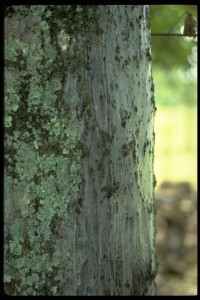 Many homeowners have been calling in the last few weeks asking about a thick webbing that has seemingly enveloped the trunks of their trees overnight. Most likely the culprit is a tiny, brownish insect known as Barklice. Barklice are interesting little insects, known more for their webbing than for their look, clustering together in a “herd” on the bark. They first appear in the spring (April) and mate. Eggs are laid singly or in clusters and are covered with a silk webbing and sometimes bark debris. Nymphs hatching from eggs resemble tiny wingless adults, developing through six stages (instars). Bark lice are gregarious and live together underneath layers of silken webbing.
Many homeowners have been calling in the last few weeks asking about a thick webbing that has seemingly enveloped the trunks of their trees overnight. Most likely the culprit is a tiny, brownish insect known as Barklice. Barklice are interesting little insects, known more for their webbing than for their look, clustering together in a “herd” on the bark. They first appear in the spring (April) and mate. Eggs are laid singly or in clusters and are covered with a silk webbing and sometimes bark debris. Nymphs hatching from eggs resemble tiny wingless adults, developing through six stages (instars). Bark lice are gregarious and live together underneath layers of silken webbing.
Barklice feed on fungi, algae, dead plant tissues and other debris. Consequently, they are considered harmless and perhaps beneficial to the trees they infest. Barklice first appear in the spring. However by late summer, the silken webbing produced by these insects can completely wrap a large tree from the base of the trunk to the tips of the branches. Some people consider this webbing to be unsightly; however if left undisturbed, these insects usually eat and remove the silk webbing before populations decline by the end of the year.
For information on Barklice, or other insects in landscape tree, contact the Texas A&M AgriLife Extension Service of Austin County at (979) 865-2072, or click on the “ASK THE AGENTS” tab.
Prepared by Philip Shackelford, PhD
County Extension Agent for Agriculture & Natural Resources
Texas A&M AgriLife Extension Service of Austin County
The information given herein is for educational purposes only. References to commercial products or trade names are made with the understanding that no discrimination is intended and no endorsement by Texas A&M AgriLife Extension Service personnel is implied.
